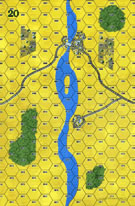|
Crimean Gateway First Axis #15 |
||
|---|---|---|
| (Defender) Slovak Republic | vs | Soviet Union (Attacker) |
| Formations Involved | ||
|---|---|---|
| Slovak Republic |  |
1st "Janošík" Infantry Division |
| Soviet Union |  |
347th Rifle Division |

| Total | |
|---|---|
| Side 1 | 0 |
| Draw | 0 |
| Side 2 | 1 |
| Overall Rating, 1 vote |
|---|
|
2
|
| Scenario Rank: --- of 913 |
| Parent Game | First Axis |
|---|---|
| Historicity | Historical |
| Date | 1943-10-28 |
| Start Time | 07:00 |
| Turn Count | 24 |
| Visibility | Day |
| Counters | 104 |
| Net Morale | 0 |
| Net Initiative | 2 |
| Maps | 4: 20, 4, 5, 7 |
| Layout Dimensions | 86 x 56 cm 34 x 22 in |
| Play Bounty | 169 |
| AAR Bounty | 171 |
| Total Plays | 1 |
| Total AARs | 1 |
| Battle Types |
|---|
| Bridge Control |
| Hill Control |
| Rural Assault |
| Conditions |
|---|
| Off-board Artillery |
| Randomly-drawn Aircraft |
| Scenario Requirements & Playability | |
|---|---|
| Eastern Front | Maps + Counters |
| First Axis | Base Game |
| Road to Berlin | Maps + Counters |
| Introduction |
|---|
|
Reorganized, more or less, as an infantry division, the Slovaks spent the spring and summer of 1943 behind the German lines. That changed when the Soviets opened a powerful offensive in southern Ukraine that fall, and the Slovaks were rushed to hold the Molochna River north of Melitopol. Known as the "gateway to the Crimea," the city and its vital rail lines had to be held or the entire peninsula would fall to the Red Army. |
| Conclusion |
|---|
|
Flung into the line as a last reserve, the Slovaks stood up poorly. The division went into battle with a ration strength of less than 8,000; at least 2,000 of them deserted to the Soviets during the course of the battle. The Red Army sliced through the Slovak defenders and quickly moved forward to the Dnepr River, where the front stabilized for many months. |
| AFV Rules Pertaining to this Scenario's Order of Battle |
|---|
|
| 2 Errata Items | |
|---|---|

|
The reduced direct fire value in Kursk: Burning Tigers is 4-4. (plloyd1010
on 2015 Jul 31)
|

|
Kommissars never get morale or combat modifiers. Ignore misprints. (Shad
on 2010 Dec 15)
|
| Foot in the Bucket | ||||||||||||
|---|---|---|---|---|---|---|---|---|---|---|---|---|
Baseball is a game that is taught to American children at an early age. It is an odd sport involving a lot of hand/eye coordination and a rule book rivaling ASL in length and complexity. My wife and I have gone to several games this year and she is learning how the game is played and rules such as the infield fly rule (a particularly notorious rule involving a ball played into the air by the batter and the potential for fielders to play the ball to their advantage, rather than the batting team's advantage), etc. No doubt baseball players were highly involved in the drafting of some of the rule books we have seen. Integral to baseball is the ability to stay in the "batter's box" while the pitcher throws the ball. Batters have a tendency to "step in the bucket" or step away from the path of the ball once it is pitched even if they intend to swing at the ball. This, of course, causes them to miss when they swing. This tendency is due to the fact that if the pitched ball hits the batter it hurts. So, it is a self defense mechanism. In FA 15 we are given the opportunity to see the Slovaks with their foot in the bucket. They are understrength, stretched and faced with a Soviet force with ample armor, tons of artillery and plentiful infantry. But perhaps more important, they are low morale. The top end "7" is no great shakes but their units dissolve once they have taken a step loss due to the low end morale of "5". The narrative points out that the Slovaks were ready to run or quit and the scenario clearly shows that impact. The Soviets were able to launch three prongs, one at each bridge and one to cross the river using engineers. It turned out that, due to incredible artillery fire, lousy morale rolls and sheer weight of direct fire both bridges had fallen to the Soviets within the first hour. By turn 9 the first hill had fallen and by turn 12 the second hill was held by one demoralized Slovak step. Two platoons occupied a one hex woods on board 7 but were going to be in sight by the next turn and the repeated high roll artillery would have destroyed them in short order. The one bright spot for the Slovaks was the 88. It managed to knock out 2 steps of T-34s and withstood 3 assaults, demoralizing an entire stack and withstanding their own OBA which hit the hex with the demoralized attackers and the 88 and caused another 2 step losses to the Soviets. The Slovaks are in quite a terrible predicament and a victory of any type depends on holding a bridge and delaying the Soviet crossings as much as possible. Given the massive amount of artillery and the low morale of the Slovaks it just doesn't seem as though there will be any Slovak victory parties with this one, even with the short timeframe, just like in reality (funny that). Instructive but not a blast, I give it a 2. |
||||||||||||
| 0 Comments |

 FiAx014
FiAx014 
































